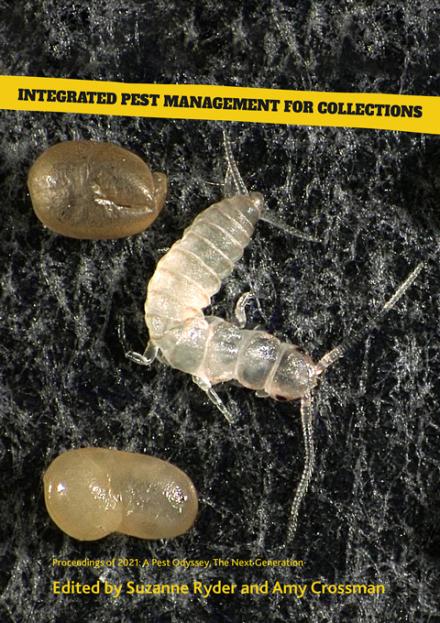Book review: Integrated Pest Management for Collections
Submitted by sharragrow on

Reviewed by Jane Eagan
Integrated Pest Management for Collections, Proceedings of 2021: A Pest Odyssey, The Next Generation.
Edited by Suzanne Ryder and Amy Crossman.
Archetype (2022)
Paperback / 262 pages / £45
ISBN 978-1-909492-83-7
This conference publication is dedicated to Bob Child (1951-2019) and opens with a personal tribute to him by long-time friend and colleague, David Pinniger. It is a lovely way to begin, recognising Bob’s contribution and also reminding us that the successes of the Pest Odyssey group build on both individual and group efforts. If you are not aware of the work of this group, I would encourage you to visit their website (accessible here), which promotes collaboration, sharing and dissemination of IPM knowledge and expertise.
Alongside advocacy and information sharing, Pest Odyssey also hold conferences with post prints, handsomely produced by Archetype Publications. This recently published peer-reviewed third volume, Proceedings of 2021: A Pest Odyssey, the Next Generation, follows an online meeting which took place 20-22 Sept 2021. Edited by Suzanne Ryder and Amy Crossman, the volume contains 46 contributions from around the globe, clearly showing that integrated pest management (IPM) has become the accepted strategy for insect and pest prevention worldwide. The message is definitely getting through!
Volume three is divided into 32 papers and 14 poster presentations. The contributions are wide-ranging in subject and geographically diverse, with papers from Abu Dhabi, Peru, Sri Lanka, Myanmar, Japan and Australia amongst other countries. The papers also cover the range and scale of IPM activity, from larger high-tech solutions to more DIY work in smaller institutions. As part of a team of book and paper conservators working in 16 historic library, archive and object collections at the University of Oxford, we carry out IPM, always eager for new methods and materials on pest identification and remedial treatment. 2021: A Pest Odyssey, and the group’s previous volumes, are a valuable source of information for us.
I found the first paper, “IPM Strikes Back”, interesting as a case-study of the problems which affect any long-running programme—namely fatigue over time, staff turnover, heavy workloads, resistance from within the organisation and poor communication (pp. 4-5). The work done to refocus the programme, improve communication and make changes to preventive activities successfully repaired relations and made for a more manageable workload.
As a low-tech IPM operator, I appreciated the following observation in the V&A’s paper “Training, Tools and Technology” that technology can never replace the work of those carrying out IPM tasks or the importance of building relationships within the team and institution (p. 30). This recurrent theme runs through many of the papers in this book and is a great take-away.
Some of my idle pest musings were clarified, such as: why does the webbing clothes moth lay eggs on cotton? In “The Attractive Qualities of Wool and Larval Frass”, Kelley, Arenstein and Feston explain that sensory hairs on the ovipositor “feel” whether the substrate is suitable, and fluffy cotton is often felt to be suitable. I was also mightily reassured that their results suggest there is no preference in attraction to previously infested processed wool.
Reflection on the history and development of IPM is another theme in this volume. I found the contributions by the National Museums of Scotland (p. 117) and National History Museum in London (p. 233) interesting explorations of the evolution of an IPM programme over 20 years, in particular the importance of communication (again) and the move in the 1970s to monitoring, recording and risk assessment from pesticides. Pinniger and Lau-der’s paper “Twenty years of IPM in practice at Eltham Palace” (p. 123) struck a particular chord for me as it deals with a large historic house that has many environments and challenges including the difficulty of housekeeping in a structure with areas which cannot be accessed for deep cleaning. The efficacy and importance of high standards of housekeeping, even if pests are present and can spread through interconnected and inaccessible voids, was a very positive message in what can sometimes seem to be a rather less-than-ideal situation.
The inclusion of papers addressing problems experienced during lockdown, such as Harris and Walker’s paper on the successful treatment of a silverfish outbreak (p. 188), gave a positive spin on the Covid-19 pandemic by highlighting the unexpected advantage of having total access to sites when the public was completely excluded (p. 188).
2021: A Pest Odyssey, The Next Generation is informative and interesting for the specialist, neophyte and jobbing conservator carrying out IPM on his/her/their own. It joins the previous Pest Odyssey publications, which are standards in IPM literature. The themes of communication, sharing the IPM message and establishing IPM as the means to prevent pest damage to cultural collections come through strongly. Plus, the cover illustration by Judith Wagner is one for the diehard entomologist!
AUTHOR BIO
Jane Eagan is head of conservation of the Oxford Conservation Consortium. She was awarded an MA in book conservation by Camberwell College of Arts. Jane was involved in editing publications for the Institute of Paper Conservation (1997-2007) and was a member of Icon’s editorial board (2008-2016). She has also served as programme advisor to West Dean College’s BA/MA book conservation course, CPD reader for Icon and in 2021 joined the Advisory Council of the Hamilton Kerr Institute. Jane is accredited by Icon and is an IIC Fellow.
(Read the review in the December-January 2023 "News in Conservation" Issue 93, p. 44-45)